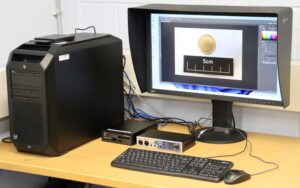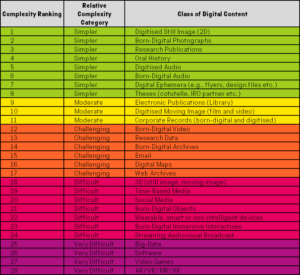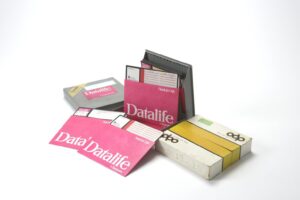In 2023 the Science Museum Group received £10,000 through The National Archives’ Resilience grant to establish our first specialist ‘ingest workstation’; a high-end computer workstation for transferring and processing digital collections. This was the first infrastructure component for the Group’s Digital Preservation Programme. The grant enabled us to procure and implement a high-end HP PC workstation and commence training staff in identifying and handling legacy media ‘carriers’ (such as floppy disks, optical media, external hard disk drives etc), as well as to begin understanding and processing digital collections.
The Science Museum Group cares for over seven million archive and library items, many of outstanding national and international significance. Our collection tells the story of our world, charting the development and history of science, technology, engineering, and medicine through many centuries. We provide public access to our archive and library collection on five of our six sites, and to our object photography via Collections Online. Digital Preservation is a new area of activity for the Science Museum Group, providing an essential foundation and the first step towards ensuring future long-term public access to born-digital and digitised collections. Our born-digital content is wide-ranging and often complex, including digital photography, scientific and research data and publications, digital and hybrid-digital artworks, audio-visual recordings, time-based media, video, digital interactives, software, video games, social media, 3D digital content, many of which are considered ‘complex digital objects’.

Figure 1: Floppy Disks in Boxes. CC-BY-NC-SA 4.0
To ensure that our born-digital content is sustainable for the long-term and accessible in future, it is critical that digital preservation equipment, software, and necessary infrastructure, including a Digital Preservation System and preservation storage are procured and implemented. The Science Museum Group is in the early stages of its Digital Preservation Programme; prior to the procuring of our first ingest workstation, initial steps had already occurred, including recruiting staff (the inaugural Digital Preservation Manager commencing in 2021, and the inaugural Digital Collections Specialist in 2023), developing a Digital Asset Register, limited collection surveying, and authoring a Digital Preservation Policy.
Prior to this grant, we lacked appropriate equipment needed to appraise, acquire and process born-digital content. The ingest workstation we have been able to procure with this grant puts the first piece of our large and complex digital preservation puzzle in place.

Figure 2: Science Museum Group’s first ingest workstation. Science Museum Group
The workstation we procured was an HP Z8 G5 computer, aligning with the Group’s ICT support arrangements. We opted for an NVIDIA RTX A5000 graphics card, dual Intel Xeon 6426Y processors, and also procured an EIZO ColorEdge CG2700S 27 inch monitor. The process of getting the ingest workstation implemented involved in-depth and collaborative work with the Group’s Cybersecurity team and other members of our ICT department; this is the first time the Science Museum Group has implemented this type of equipment.
This might seem like a high specification workstation for processing archives; however, the Group has to handle a wide range of digital content. We currently have twenty-eight categories of digital content – as shown in Figure 3 (many of which are found on the Digital Preservation Coalition’s Bit List of Endangered Digital Species) – including large files such as ‘big data’ and high quality born-digital and digitised video from the Science Museum Group’s archives that will need to be processed and Quality Control (QC) checked in future.

Figure 3: Digital Formats Complexity Scale. Science Museum Group
Our ingest workstation will enable digital content currently held on the more common types of legacy carriers – including 3.5 inch floppy disks, optical media (such as CDs and DVDs), FireWire external hard disk drives – and other digital acquisitions to be processed. Other older legacy media such as 3 inch, 5.25 inch, and 8 inch floppy disks in our collection still require even more custom hardware to be implemented in future.

Figure 4: Media containing samples for Fairlight CMI Series 3. 1985-1995. CC-BY-NC-ND 4.0
Alongside the equipment procurement, guidelines and procedures for staff transferring digital content from selected carriers were developed, marking the beginning of a fundamental change in how we manage these collections. An Archives & Libraries staff skills audit indicated skills gaps and a desire to learn about digital collections. Once the ingest workstation had arrived, staff training across the Group was organised. Staff working with archives and digital collections across five of the Group’s sites attended carrier identification and handling training, developed and delivered by the Digital Preservation Manager. This has now been rolled out as a series of videos recorded for our online e-learning platform. Additionally, staff at the site where this workstation is located were trained in how to use it.
Our first ingest workstation has marked a significant step in the start of our digital preservation journey, helping to build our capacity. Going forward, we are taking an incremental approach to extending the capabilities of this workstation. As each new digital collection arrives, we continue to work with ICT and the Cybersecurity team to test and install any new required software and put in place any additional necessary processes. We manage the specifics of each acquisition on a case-by-case basis. Our first ingest workstation has paved the way for the start of operational digital preservation at the Science Museum Group.
Katie Flanagan, Group Head of Archives and Libraries, and Somaya Langley, Digital Preservation Manager